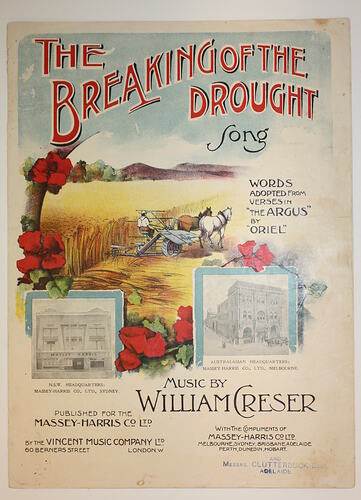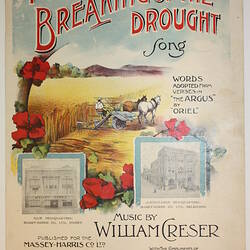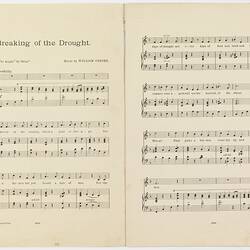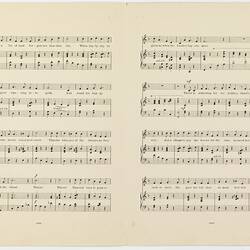Summary
The song was a marketing tool used by the Canadian company Massey Harris, following the breaking of the Federation Drought in Australia in 1904.
The Federation Drought, which began in the early 1890's reached its peak in severity across Australia in 1902. It is considered one of the most significant natural disasters in Australia's settlement history. Sheep and cattle numbers were decimated by up to 50%, wheat crops failed, and many farmers were forced to leave the land. The drought also brought with it the trauma of extreme heat waves, dust storms, rabbit plagues and bushfires. This songbook is an example of the many cultural expressions and understandings the lived experience of Australia's variable climate.
This songbook has strong links to the H.V. McKay Sunshine Collection. The Federation Drought placed significant pressure on the H.V. McKay enterprise; by 1902 it had 200 new harvesters but no Australian market - farmers had no income to purchase new equipment. In a typically innovative and enterprising way, McKay used the crisis of the Federation Drought to launch an export market with direct sales of his Sunshine harvesters to Argentina. By 1904 McKay was the largest manufacturing exporter in Australia. It is significant that this song book is used as a marketing tool by one of McKay's strongest competitor's, the Canadian firm Massey Harris, who like McKay would have been quick to capture the opportunities to sell to farmers following the break of the Federation drought. Both companies eventually merged in 1930 to create McKay Massey Harris.
This item is also supported by other related collections that reference drought, including the Mallee Climate Oral History Collection, the Victorian Women on Farms Gathering Collection, the Invisible Farmer Collection, the Victorian Bushfires Collection and the Water Smart Home Collection.
Physical Description
Printed sheet music with colour cover.
Significance
This item evokes the realities of climate variability and the challenges of drought (and the associated heat waves, dust storms, rabbit plagues and bushfires) which are a recurring feature of Australian agriculture and Australian history. In the early 20th century drought not only impacted farms and rural communities, but also had very direct impact on the broader Australian economy and community, and fundamentally shaped the national and cultural identity of Australians.
More Information
-
Collecting Areas
-
Creator
-
Classification
Agriculture & rural life, Crop management - cultivation, Tools & equipment
-
Category
-
Discipline
-
Type of item
-
Keywords
Agricultural Equipment, Droughts, Farming, Marketing, Sales, Song Books






